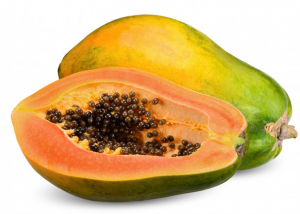 Scientific name: Carica papaya
Scientific name: Carica papaya
Usage
Traditional/Ethnobotanical uses
Papain has many industrial uses, as well as milk-clotting (rennet) and protein-digesting properties. Nearly 80% of American beer is treated with papain, which allows the beer to remain clear upon cooling. Papain is most commonly used commercially in meat tenderisers and chewing gums. Cosmetically, papain is used in some toothpaste, shampoos, and facial creams.
Miscellaneous uses
Papaya has been used widely in folk medicine for many ailments: the juice for warts, corns, cancer, tumours, and thickened skin; the roots or extracts for uterine cancer, syphilis, the tropical infection, haemorrhoids, and to remove mineral concretions in the urine; the unripe fruit as a mild laxative or diuretic, and to stimulate lactation, labour, or abortion; the ripe fruit for rheumatism and alkalinising the urine; the seeds for intestinal worms or to stimulate menstruation or abortion; the leaves as a poultice for nervous pains and elephantoid growths, or smoked for asthma relief; and the latex for psoriasis, ringworm, indigestion, or applied externally as an antiseptic or to heal burns or scalds, or applied to the cervix to contract the uterus.
General uses
In some developing countries, the traditional use of papaya is being investigated as an alternative to standard treatments for a range of ailments. C. papaya has a wide range of purported medicinal properties for treatment of diabetes, as birth control, an antiseptic, an antimicrobial, a diuretic, to control parasites, to reduce inflammation, to lower blood pressure, and to lower cholesterol. While there are only limited data to support most of these uses, there is some evidence for healing bed sores and other wounds, and in treating intestinal worms in humans (Kluwer, 2010).
Country of Origin
The papaya is believed to be native to southern Mexico and its neighbouring Central America. It is now present in every tropical and subtropical country (Growers, 1997).
Time to harvest
After planting a small plant in the ground, it may take 8 to 10 months before the fruits are ready to harvest. The climate does play a role in the number of months a papaya needs to grow and bear ripe fruit. In hot regions, it can take as little as 6 to 9 months until harvest after planting the seeds, but more temperate areas need 9 to 11 months to produce fruit when grown from seeds. If planted later in the year, the cooler fall and winter seasons slow the growth and increase the number of months the plant requires before producing fruit for harvest (Hessong, 2018).
Share with:

